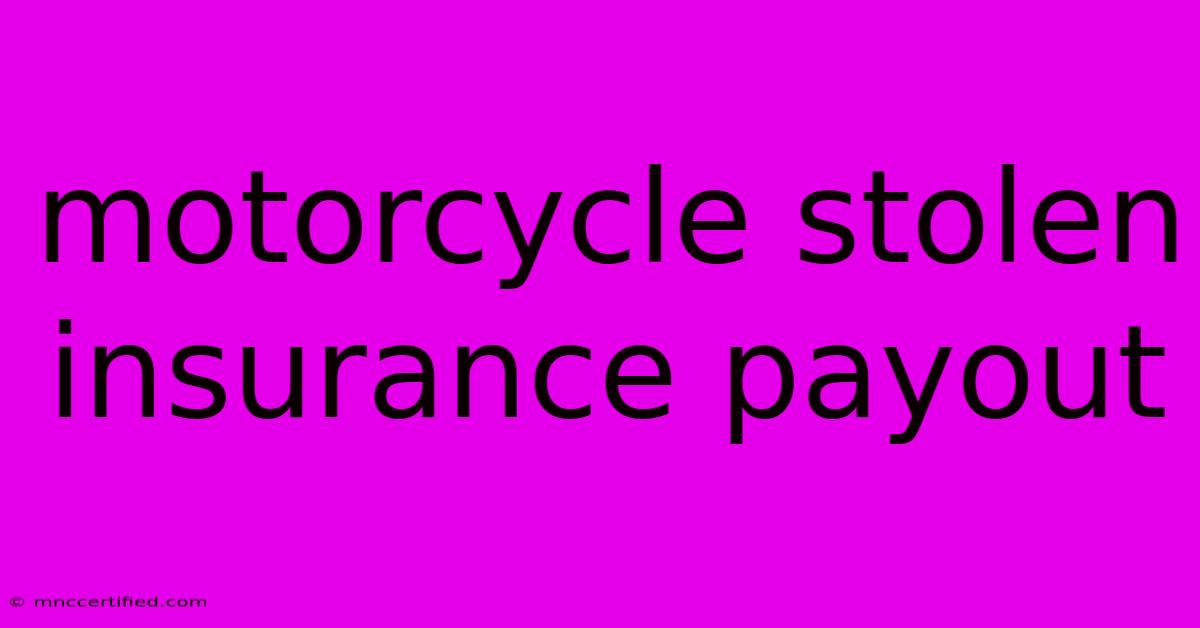Motorcycle Stolen Insurance Payout

Table of Contents
Motorcycle Stolen: Understanding Your Insurance Payout
Having your motorcycle stolen is a devastating experience. Beyond the emotional loss, you're left facing the financial implications. This is where your motorcycle insurance comes in. But understanding what your insurance payout will actually cover can be confusing. This comprehensive guide will walk you through the process of claiming a payout after your motorcycle is stolen, explaining key factors that influence the amount you receive.
What to Do Immediately After Your Motorcycle is Stolen
Before you even think about the insurance payout, there are crucial steps to take immediately after discovering your motorcycle has been stolen:
- Report the theft to the police: Obtain a police report number. This is absolutely essential for your insurance claim. The police report provides official documentation proving the theft occurred.
- Contact your insurance provider: Notify your insurer as soon as possible. They'll guide you through the claims process and provide necessary forms. The sooner you report it, the smoother the process usually is.
- Gather all relevant documents: This includes your insurance policy, registration papers, proof of purchase, and any photos or videos you have of your motorcycle. The more documentation you can provide, the stronger your claim will be.
- Check your policy details: Carefully review your policy to understand your coverage limits, deductibles, and any exclusions. Knowing what your policy covers before you file a claim prevents surprises later.
Factors Affecting Your Motorcycle Insurance Payout
Several factors influence the final payout you receive after a motorcycle theft:
1. Your Insurance Policy Type and Coverage
- Comprehensive coverage: This is the most comprehensive type of coverage and typically covers theft. It usually reimburses you for the actual cash value (ACV) of your motorcycle at the time of theft, minus your deductible.
- Collision coverage: This covers damage to your motorcycle in an accident, but typically doesn't cover theft. Make sure you understand your specific policy's stipulations.
- Liability coverage: This only covers damage or injury you cause to others, not your own losses. It won't compensate you for a stolen motorcycle.
Understanding your policy's specific wording is crucial. Don't hesitate to contact your insurance provider to clarify any ambiguities.
2. Actual Cash Value (ACV) vs. Replacement Cost
- Actual Cash Value (ACV): This is the most common method of calculating the payout. It considers the motorcycle's value at the time of theft, factoring in depreciation, mileage, and condition. This means you likely won't receive the price you originally paid.
- Replacement Cost: Some policies offer replacement cost coverage, meaning you'll receive enough money to replace your motorcycle with a similar model. This is less common and typically more expensive.
Knowing the difference between ACV and replacement cost is vital for managing your expectations.
3. Deductible
Your deductible is the amount you're responsible for paying out-of-pocket before your insurance coverage kicks in. A higher deductible usually means lower premiums, but a larger upfront cost in case of a claim.
4. Proof of Ownership and Value
Providing strong evidence of ownership and the motorcycle's value is key. This includes:
- Proof of purchase: Your sales receipt or bill of sale.
- Registration documents: Your motorcycle's registration certificate.
- Photos and videos: Documentation of the motorcycle's condition before the theft.
- Appraisals: A professional appraisal can strengthen your claim, particularly for high-value motorcycles.
Maximizing Your Motorcycle Insurance Payout
To improve your chances of receiving a fair payout:
- Maintain detailed records: Keep records of all maintenance, repairs, and upgrades.
- Take clear photos and videos: Document your motorcycle's condition regularly.
- Consider gap insurance: This covers the difference between what your insurance pays and the amount you still owe on your loan if your motorcycle is totaled or stolen.
- Understand your policy: Read your policy thoroughly and ask questions if anything is unclear.
The Claim Process: Step-by-Step
The claims process typically involves:
- Filing a claim: Contact your insurer and provide all necessary documentation.
- Investigation: The insurer may investigate the theft.
- Assessment: The insurer will assess the value of your motorcycle.
- Settlement: You'll receive a payout, minus your deductible.
Navigating the process of a stolen motorcycle claim can be challenging. Understanding your policy, gathering all necessary documents, and communicating effectively with your insurance provider are key to ensuring a successful outcome. Don't hesitate to seek legal advice if you have disputes with your insurance company.

Thank you for visiting our website wich cover about Motorcycle Stolen Insurance Payout. We hope the information provided has been useful to you. Feel free to contact us if you have any questions or need further assistance. See you next time and dont miss to bookmark.
Featured Posts
-
Live Transfer Life Insurance Leads
Nov 16, 2024
-
How Much Is Xray Without Insurance
Nov 16, 2024
-
Ireland Vs Argentina Tv And Live Stream
Nov 16, 2024
-
Davina Mc Call Out Of Brain Tumor Surgery
Nov 16, 2024
-
Is No Insurance A Moving Violation
Nov 16, 2024